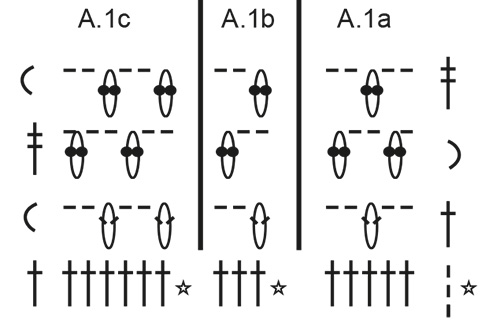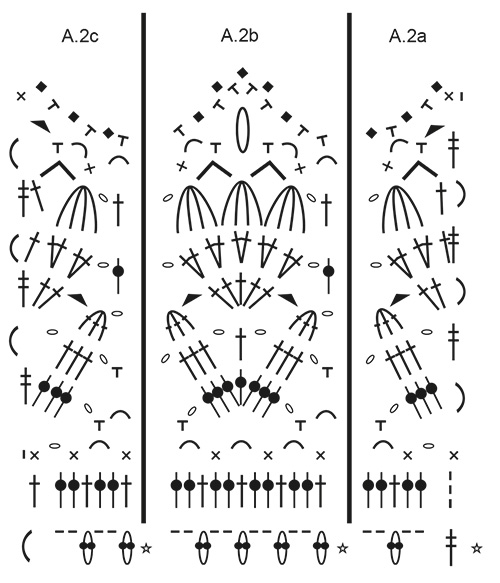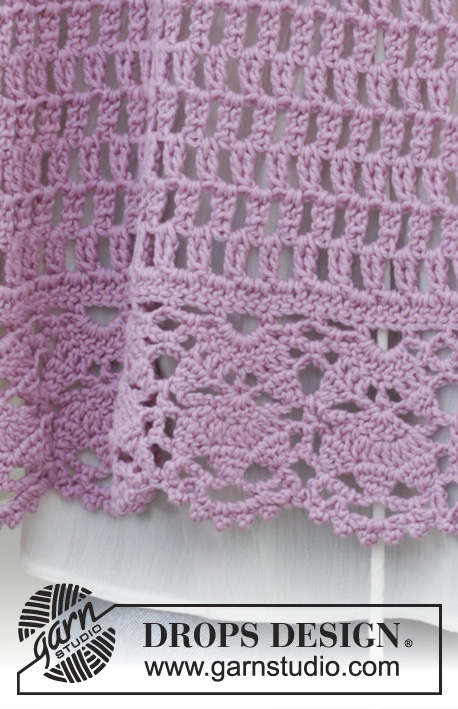Comments / Questions (5)
![]() Andrea wrote:
Andrea wrote:
Hallo, mit 92 Luftmaschen am Anfang erhalte ich eine Breite >50cm für die Stola und nicht 36cm wie angegeben. Ich möchte nur eine Breite von 36cm haben. Was kann ich tun? Viele Grüße, Andrea
12.03.2022 - 16:10DROPS Design answered:
Liebe Andrea, oft häkelt man die Luftmaschen etwas fester als später die Maschen, um das auszugleichen, schlägt man mehr Luftmaschen an = 92 Luftmaschen, in der 1. Reihe überspringt man dann in regelmäßig Abstand 1 Lm, damit der Rand nicht zu stramm und eng wird und elastisch bleibt - und so haben Sie 73 Stäbchen am Ende der 1. Reihe und 36 cm in der Breite (mit 16 M = 10 cm). Viel Spaß beim häkeln!
14.03.2022 - 10:45
![]() Frédérique wrote:
Frédérique wrote:
Bonjour, si je veux le faire plus large, je dois prendre quel multiple de nombre de mailles s’il-vous-plaît?
26.02.2022 - 13:08DROPS Design answered:
Bonjour Frédérique, ajoutez 12 mailles pour chaque A.2b en largeur (= 1 fleur en plus pour la bordure), vous aurez ainsi 4 motifs de A.1b en plus en largeur pour 1 fleur en plus. Bon crochet!
28.02.2022 - 09:20
![]() Maya wrote:
Maya wrote:
Hur slutar jag varv i A. 1a och A. 1c? Vad betyder C ? Bästa hälsningar Maya
17.12.2020 - 08:55DROPS Design answered:
Hei Maya. A.1a og A.1c avsluttes med en dobbeltstav i masken under (masken under er et ikon som en litt strekt C som igjen betyr 4 luftmasker), altså man avslutter i 4. luftmaske. mvh DROPS design
21.12.2020 - 12:56
![]() Birgitta Svaneblom wrote:
Birgitta Svaneblom wrote:
Hej. Den är läcker
08.01.2018 - 14:40
![]() Chrissie wrote:
Chrissie wrote:
Schöne Stola, tolle Borte!
04.01.2018 - 22:05
French Lavender#frenchlavenderscarf |
||||||||||||||||||||||||||||||||||||||||||||||||||||
|
|
||||||||||||||||||||||||||||||||||||||||||||||||||||
Crocheted stole with lace pattern and fans. The piece is worked in DROPS Cotton Merino.
DROPS 191-35 |
||||||||||||||||||||||||||||||||||||||||||||||||||||
|
INFORMATION FOR THE PATTERN: PATTERN: See diagrams A.1 and A.2. ---------------------------------------------------------- STOLE: The piece is worked back and forth in 2 similar pieces. You work from the middle of the stole and out to the side. FIRST HALF: Work 92 chain stitches with hook size 4.5 mm/US 7 and Cotton Merino. Turn and work 1 double crochet in the 4th chain stitch from the hook (= 2 double crochets), work 1 double crochet in each of the next 3 chain stitches, * skip 1 chain stitch, 1 double crochet in each of the next 4 chain stitches *, work from *-* a total of 17 times = 73 double crochets. Then work pattern according to the diagrams as follows (the first row starts from the wrong side): Work A.1c over the first 7 double crochets, A.1b over the next 60 double crochets (= 20 repeats) and A.1a over the last 6 double crochets. When A.1 is finished in height, repeat the last 2 rows onwards - REMEMBER THE CROCHET GAUGE! Continue like this until the piece measures approx. 70 cm / 27½" in height - adjust so that you have worked the last row in the diagram. Then work as follows: Work A.2a, A.2b a total of 5 times in width, finish with A.2c. Continue the pattern like this until A.2 has been completed in height, cut and fasten the strand. The first half measures approx. 79 cm/31". SECOND HALF: Work in the same chain stitches as the first row of double crochets at the beginning of the first half of the stole. Fasten the strand with 1 slip stitch and start on the first row in the diagram. |
||||||||||||||||||||||||||||||||||||||||||||||||||||
Diagram explanations |
||||||||||||||||||||||||||||||||||||||||||||||||||||
|
||||||||||||||||||||||||||||||||||||||||||||||||||||

|
||||||||||||||||||||||||||||||||||||||||||||||||||||

|
||||||||||||||||||||||||||||||||||||||||||||||||||||
Have you finished this pattern?Tag your pictures with #dropspattern #frenchlavenderscarf or submit them to the #dropsfan gallery. Do you need help with this pattern?You'll find 9 tutorial videos, a Comments/Questions area and more by visiting the pattern on garnstudio.com. © 1982-2025 DROPS Design A/S. We reserve all rights. This document, including all its sub-sections, has copyrights. Read more about what you can do with our patterns at the bottom of each pattern on our site. |
||||||||||||||||||||||||||||||||||||||||||||||||||||

























































Post a comment to pattern DROPS 191-35
We would love to hear what you have to say about this pattern!
If you want to leave a question, please make sure you select the correct category in the form below, to speed up the answering process. Required fields are marked *.